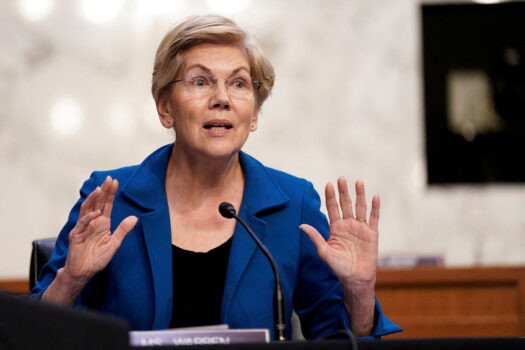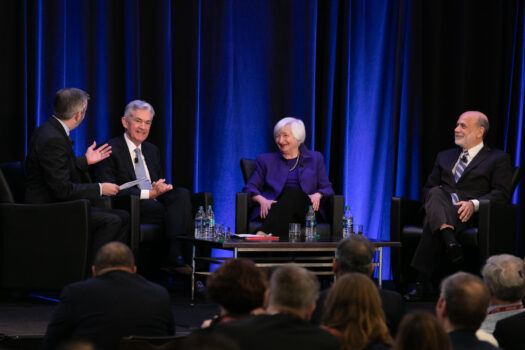
In a viral exchange back in March, Sen. Elizabeth Warren (D-Mass.) grilled Federal Reserve Chair Jerome Powell over the unemployment caused by the Fed’s recent rate hiking cycle.
“Do you call laying off two million people this year not a ‘sharp’ increase?” the senator asked. “Explain that to the two million families who are going to be out of work.”
Warren is not the only lawmaker to pressure the central bank to soften its fight against inflation. At the start of the month, she and nine other members of Congress—including Reps. Pramila Jayapal (D-Wash.) and Sheldon Whitehouse (D-R.I.) and Sen. Bernie Sanders (I-Vt.)—penned a letter to Chair Powell urging him to pause interest rate hikes at the upcoming meeting, a plea he did not grant.
The central bank and its chair continue to come under intense pressure as high interest rates take their toll on the jobs market. However, one investor with decades of experience in equity markets takes issue with the premise that today’s rates are “high” at all.
“The problem is not that we have interest rates at five percent,” Matterhorn Asset Management senior adviser Grant Williams told The Epoch Times. “If you look back over time, you’ll find that’s a perfectly sensible cost of capital.”


In fact, you don’t have to look too far back. The average Federal Funds Rate (FFR)—the overnight lending rate managed by the Fed—from 1971 to 2023 was around 5.4 percent, not far from today’s rate of 5.08 percent.
Williams acknowledged that, despite how today’s rates fit in historical context, we are already seeing catastrophic results, with three major banks failing in the span of just two months. For this financial fragility—like Warren and other lawmakers—he places the blame squarely at the feet of the central bankers. Where Williams differs from Congress is in identifying which Fed policy was the mistake.
“The real problem here—and the dislocation in all those congressional hearings—is that they’re blaming the [central] banks for raising interest rates instead of blaming the banks for keeping rates at zero for so long,” he said. “That’s the problem.”
Under Ben Bernanke—a Bush appointee to be renominated by Obama—the Fed’s target rate was held at near-zero levels from December of 2008 until then-Chair Janet Yellen attempted to gradually lift off in November of 2015. The COVID-19 pandemic also saw unprecedented levels of Fed intervention under President Donald Trump and Powell. According to Williams, these were the Fed’s big mistakes.
“This mess they’re creating now is really the result of all the other messes they’ve created in the past.”


Williams, also the author of a monthly financial newsletter, nonetheless believes that while raising interest rates may be the right thing to do in the long run, it will almost certainly “break something.” In this case, he argued that the past is precedent.
“That’s the way all these cycles work.”
If one looks at a chart of the Fed’s target rate over the last 100 years, it becomes apparent that most of the major financial crises (those large enough to be named) coincide with local peaks in the FFR. The 2008 recession, for example, hit after interest rates plateaued at 5.25 percent, right around where they are today.
In Williams’s view, it’s highly likely that this rate-hiking cycle will flip and become a rate-cutting cycle sometime in the near future. Admittedly, he doesn’t know when and cautions investors from trying to trade around the Fed’s decision-making.
“We don’t know what it will take to buckle Jerome Powell,” he said. “It’ll happen, but if you make that your case and invest like it’s going to happen tomorrow, the time between now and that happening could be very painful for you.”
With his personal portfolio, Williams is looking East.
“On the equity side of things, I happen to think Japan is finally starting to look attractive given decades of it being a poor place to invest your money and offering all kinds of false hope.”


In recent years, economic growth in Japan has been sluggish compared to the United States, with the change in GDP hovering around the zero level and at times dipping below. Undeterred by its recent history, Williams sees a rising sun on the horizon.
“At the height of its power [Japan] was the second-largest economy in the world. It’s GDP was $5.5 trillion versus the U.S. at the time at $7.5 trillion,” he said “People forget that.”
“With inflation coming back, with a chance of yields going higher, with a chance of Japanese money coming back into Japan, and you look at the state of the balance sheet of Japanese companies, there are some really attractive companies there, world-class companies.”
“I think Japan is going to be the place where a lot of people look to put money to work in the next couple of years.”
Subscribe to George Magazine and unlock exclusive bonuses. Your subscription now includes a free crypto essentials guide and three premium downloadable images. These images are perfect for personal use as desktop or mobile backgrounds, with thumbnail previews shown below.
![Enjoy the [Road] Show Travel Mug with Handle, 14ozEnjoy the [Road] Show Travel Mug with Handle, 14oz](https://georgemagazine.com/wp-content/uploads/2024/08/479070202831754764_2048-300x300.jpeg)



Discount Applied Successfully!
Your savings have been added to the cart.